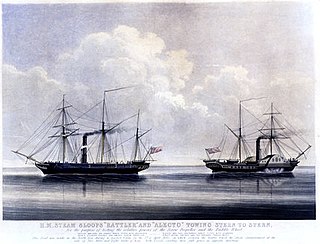
Steam frigates and the smaller steam corvettes, steam sloops, steam gunboats and steam schooners, were steam-powered warships that were not meant to stand in the line of battle. The first such ships were paddle steamers. Later on the invention of screw propulsion enabled construction of screw-powered versions of the traditional frigates, corvettes, sloops and gunboats.

A screw sloop is a propeller-driven sloop-of-war. They were popularized in the mid-19th century, during the introduction of the steam engine and the transition of fleets to this new technology.

The eighth HMS Shannon was the first British armoured cruiser. She was the last Royal Navy ironclad to be built which had a propeller that could be hoisted out of the water to reduce drag when she was under sail, and the first to have an armoured deck.

HMS Royal Sovereign was originally laid down as a 121-gun first-rate ship of the line of the Royal Navy. She would have mounted sixteen 8 in (200 mm) cannon, 114 32-pounder (15 kg) guns, and a 68-pounder (31 kg) pivot gun. With the rise of steam and screw propulsion, she was ordered to be converted on the stocks to a 131-gun screw ship, with conversion beginning on 25 January 1855. She was finally launched directly into the ordinary on 25 April 1857. She measured 3765 tons burthen, with a gundeck of 240 feet 6 inches (73.30 m) and breadth of 62 feet (19 m), and a crew of 1,100, with engines of 780 nhp.

HMS Vixen was an armoured composite gunboat, the only ship of her class, and the third ship of the Royal Navy to bear the name. She was the first Royal Navy vessel to have twin propellers.

HMS Rattler was a 9-gun steam screw sloop of the Royal Navy, and one of the first British warships to be completed with screw propulsion. She was originally ordered as a paddle wheel 4-gun steam vessel from Sheerness Dockyard on 12 March 1841. She was reordered on 24 February 1842 as a propeller type 9-gun sloop from HM Royal Dockyard, Sheerness, as a new vessel. William Symonds had redesigned the ship as a screw propeller driven vessel.
HMS Waterwitch has been the name of several Royal Navy vessels:

HMS Montagu was a Duncan-class pre-dreadnought battleship of the British Royal Navy. Built to counter a group of fast Russian battleships, Montagu and her sister ships were capable of steaming at 19 knots, making them the fastest battleships in the world. The Duncan-class battleships were armed with a main battery of four 12-inch (305 mm) guns and they were broadly similar to the London-class battleships, though of a slightly reduced displacement and thinner armour layout. As such, they reflected a development of the lighter second-class ships of the Canopus-class battleship. Montagu was built between her keel laying in November 1899 and her completion in July 1903. The ship had a brief career, serving for two years in the Mediterranean Fleet before transferring to the Channel Fleet in early 1905. During wireless telegraphy experiments in May 1906, she ran aground off Lundy Island. Repeated attempts to refloat the ship failed, and she proved to be a total loss. She was ultimately broken up in situ.

The Iris class consisted of two ships, HMS Iris and HMS Mercury, built for the Royal Navy in the 1870s. They were the first British all-steel warships.
HMS Viper was an armoured iron gunboat, the only ship of her class, and the fourteenth ship of the Royal Navy to bear the name.

HMS Rattlesnake was a unique design of torpedo gunboat of the Royal Navy. A result of the Russian war scare of 1885, she was designed by Nathaniel Barnaby that year and built by Laird Brothers, of Birkenhead. Quickly made obsolete by the new torpedo boat destroyers, she became an experimental submarine target ship in 1906, and was sold in 1910.

SS Archimedes was a steamship built in Britain in 1839. She was the world's first steamship to be driven successfully by a screw propeller.

The Aetna-class ironclad floating batteries were built during the Crimean War for the attack of Russian coastal fortifications.

HMS Niger was originally slated to be built as a Sampson designed sloop; however, she was ordered as a First-Class sloop with screw propulsion on 20 February 1845 to be built at Woolwich Dockyard, along the design developed by Oliver Lang and with a hull like the Basilisk designed paddle sloops. Her armament and engine were to be like the Encounter Design building at Pembroke. A second vessel (Florentia) was ordered on 26 March 1846 but after her keel was laid at Pembroke Dockyard, her construction was suspended on 6 October 1846 then cancelled three years later, on 22 May 1849. Niger She conducted important propulsion trials, finally proving the superiority of screw propulsion and served in West Africa, the Crimea, China, the East Indies and Australia. She took part in the New Zealand wars in 1860 and was sold for breaking in 1869.
Empire Curlew was a 4,273 GRT ferry that was built in 1945 as LST Mk.3 HMS LST 3042 by Harland & Wolff, Govan, Scotland for the Royal Navy. In 1947, she was renamed HMS Hunter. During the Suez Crisis in 1956, she was transferred to the Ministry of Transport and renamed Empire Curlew. She served until 1962, when she was scrapped.

The Ister-class frigates were a group of five 36-gun screw frigates ordered for the Royal Navy in the early 1860s. Four of the ships were cancelled after they were laid down and HMS Endymion was the only ship completed.
Humphrys, Tennant and Dykes was a British engineering company based in Deptford, London, England.

HMS Encounter was ordered as a First-Class Sloop with screw propulsion on 5 February 1845 to be built at Pembroke, in accordance with the design developed by John Fincham, Master Shipwright at Portsmouth. Her armament was to consist of 8 guns. She was to have a more powerful steam engine rated at 360 nominal horsepower. In 1848 she would be altered abaft and lengthened at Deptford prior to completion. A second vessel (Harrier) was ordered on 26 March 1846 but after her keel was laid at Pembroke Dockyard, her construction was suspended on 9 September 1846 then cancelled five years later, on 4 April 1851. Encounter had her armament radically altered in 1850 and she was broken up at Devonport in 1866.

HMS Dwarf was launched in 1840 as the mercantile Mermaid. The Royal Navy purchased her in 1843 as the Navy's first screw-propelled vessel. She was broken up in 1853.

















